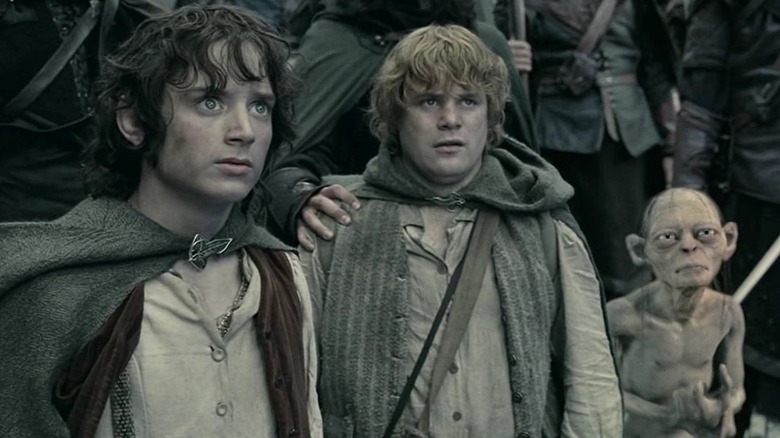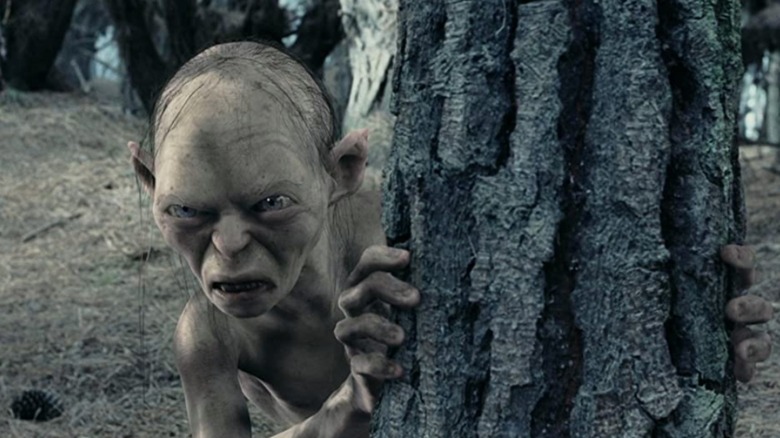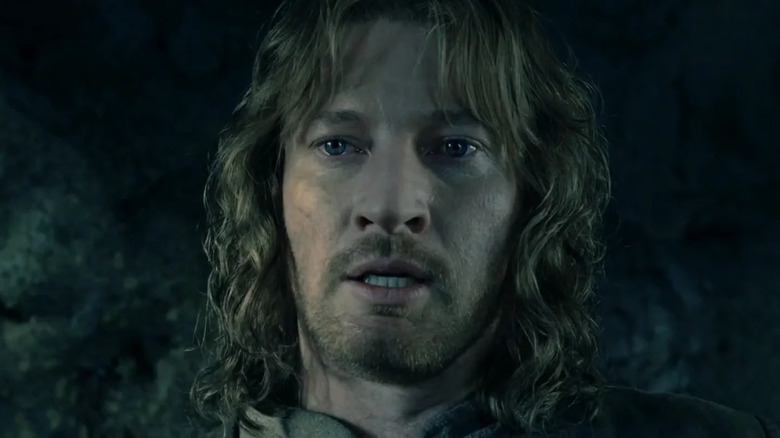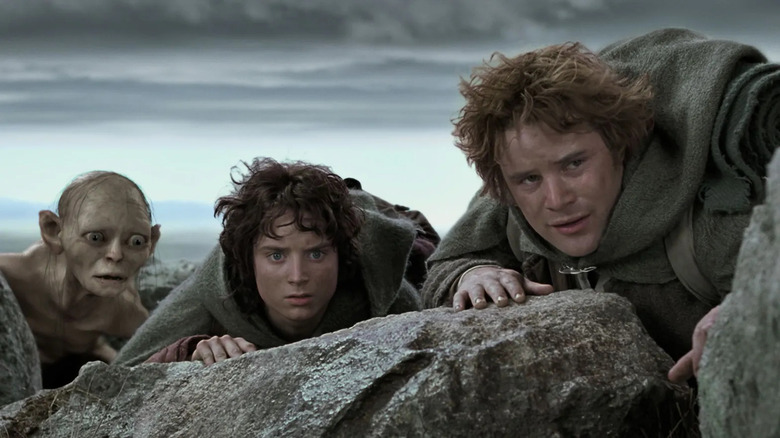The Lord Of The Rings: The Two Towers Deleted Scene That Should Have Been In The Movie
The outstanding behind-the-scenes documentary of "The Lord of the Rings: The Two Towers" on the extended edition DVDs and Blu-rays features footage of Elijah Wood as Frodo Baggins in makeup that resembles a Gollum-like creature. He has thin hair, black nails, and blue eyes as pale as his wafer-thin skin. He stands with his back turned, rocking back and forth in mental and physical anguish.
The scene would have taken place shortly after Faramir discovers that Frodo has possession of the Ring. Pulling the prized possession closer with the tip of his sword, Faramir backs Frodo up into the rocks behind him. Suddenly, Frodo grabs the Ring and screams, "No!" and turns away, trembling in fear. There is a beat between the close-ups of Faramir's startled reaction that indicates where director Peter Jackson removed Faramir's brief but shocking vision of what would happen if Frodo kept the One Ring.
The Frodo as Gollum sequence was not included in either the theatrical or extended version of "The Lord of the Rings: The Two Towers." Hopefully, someday Peter Jackson will release an even longer extended version of the trilogy so we can see it restored. However, the unsettling sequence should have been incorporated into the original film. It is a small but significant moment that provides greater depth and context to the characters' emotional journeys.
Frodo's compassion for Gollum
"The Lord of the Rings: The Two Towers" is split into three separate storylines after the breaking of the fellowship. Frodo and Sam come across Gollum, who becomes their guide to Mount Doom and brings tension to their friendship. Sam cannot understand why Frodo is being kind to the volatile former hobbit. Frodo scolds Sam for calling Gollum names and "run[ning] him down all the time." Gollum knowingly drives a wedge between the friends so that he can claim the One Ring for himself, which Sam calls out. He begs Frodo to recognize Gollum's manipulation and lies, but Frodo identifies with the troubled creature because they've both carried the Ring: "You have no idea what it did to him ... what it's still doing to him. I want to help him, Sam," he says.
Frodo wants to believe that Gollum can be saved and the evil of the One Ring can be defeated. If Gollum is able to come back from the damage the Ring caused, that means Frodo can, too. Frodo is afraid that even if he manages to destroy the Ring, the grip it has on him will last forever. He has compassion for Gollum because he knows how painful it is to carry Sauron's treasure and how easy it would be to succumb to its hypnotic power.
The deleted scene would solidify Frodo and Gollum's deep connection, making it clear why Frodo cares about Gollum so much despite his faults. This shocking, in-your-face moment would confront the audience with the grim reality of Frodo's internal struggle with the Ring, how that makes him empathize with Gollum, and how easily Frodo could become the next Gollum.
Boromir and Faramir's reactions to the One Ring
The inclusion of the Frodo-turned-into-Gollum scene would also highlight the contrast between Faramir and Boromir, particularly their understanding of the Ring's power. The film version of Faramir is quite different than J.R.R. Tolkien's novels. In order to draw more dramatic tension, Peter Jackson made him more brooding and conflicted about his new leadership role after Boromir's death at the end of "The Lord of the Rings: The Fellowship of the Ring." In the books, Faramir is immediately kind to Frodo and Sam and deeply concerned for their safety. He does not treat the hobbits with contempt or capture them and bring them to Osgiliath.
Boromir is more outspoken and headstrong, determined to take action and save his people. Despite Gandalf's warnings about its evil, Boromir believes he can use the One Ring to challenge Sauron. He quickly becomes seduced by its power and threatens Frodo for it. Faramir is also tempted by the Ring, seeing it as an opportunity to "show his quality" to his father who favors Boromir.
By including the troubling vision of Frodo, Peter Jackson would draw a sharper contrast between the brothers, emphasizing Faramir's strength and quiet wisdom relative to Boromir. Faramir is able to see what Boromir could not recognize: The Ring's insidious nature and what it does to those in its possession. If the One Ring falls into the wrong hands — especially somebody as unhinged as the ruling Steward of Gondor, Denethor — then Middle-earth is doomed. Unlike Boromir, Faramir recognizes the full scope of its dangerous ability and is able to let Frodo go for the greater good of destroying the Ring.
Frodo's soul is at stake
The deleted scene would give viewers a frightening glimpse into what could happen to Frodo if he fails his mission. The sight of the happy-go-lucky hobbit wasting away into a tormented figure is emotionally devastating. By seeing this outcome, we can understand how hard Frodo fights against the Ring's vices of greed, deceit, and obsession. Could Frodo snap and murder Sam just like Sméagol did to his best friend Déagol? The deleted scene would solidify how important it is for Frodo to get to Mount Doom and destroy the Ring as quickly as possible so that does not happen.
Thanks to Elijah Wood's captivating performance, "The Lord of the Rings: The Two Towers" did not need to include Frodo transforming into Gollum to convey the Ring's impact. Wood already does this through his pensive disposition and large, haunted eyes. But the moment would have been a jolting, horror-esque surprise for the audience and would reiterate what is at stake for Frodo.
The scene would also clarify the strength it takes for Frodo to complete the quest. It is a testament to his sheer will and perseverance, along with Sam's support, that he is able to defy Sauron and resist following in Gollum's footsteps. It takes a lot for Frodo to avoid becoming a sad creature hunched in a corner, keeping the Ring for himself and leaving the fate of Middle-earth to ruin.



